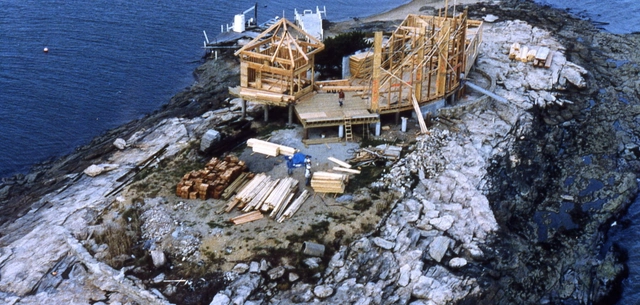
This article was originally published on Common Edge.

A building architect who writes.

This article was originally published on Common Edge.
Every field has its heroes. In architecture, heroic designers have often been celebrated both for their skills and as public personalities. Frank Lloyd Wright and Louis Kahn were icons in the 20th century. In the 21st, Zaha Hadid was as bold and evocative as her buildings, and she became a “starchitect” (to use the industry-specific parlance), her untimely death further elevating her to what-might-have-been status. But heroes are only human, and their deaths do not automatically convey a permanent place in the pantheon. They do, however, allow for a fresh perspective on the living.

This article was originally published on Common Edge.
This summer the federal government released an astonishing statistic: 87% of American homes are now equipped with air conditioning. Since the world is getting undeniably warmer, I suppose this isn’t all that surprising, but keep in mind that robust number of mechanically cooled homes include residences in some fairly temperate climates. So my question is a simple one: When did air conditioning in the U.S. became a requirement, rather than an add-on?


This article was originally published on Common Edge.
"I hate this whole ‘beauty’ thing,” says a deeply talented architect and professor friend, reacting to an emerging ripple in the zeitgeist. He is not alone. Words are dangerous things. Since World War II, there has been a consensus mainstream in architecture: the Modernist canon. But change is coming in the profession—and in our culture.

The true believers cringe at the word “beauty” as a design criterion. They dismiss the word “style,” too. Like all orthodoxies, there is simply “right” and “wrong.” The realities of the “wrong” are writ large in architectural orthodoxy: “wrong” is anything allusive to anything but that canon itself. Closed-loop rationalization gives comfort to the convicted.
.jpg?1561559584&format=webp&width=640&height=580)
This article was originally published on Common Edge.
Architects compete, and the internet provides unlimited opportunities for competition among all who wish to offer up something for consideration. None of this is news. But there’s been a change in both the expectations and the etiquette around all of those offerings.

Earlier this month, I was asked to submit to two small competitions. I had completed successful projects that matched each competition’s focus, so I dove in. We confirmed that our entries met the criteria and deadlines; we knew the day of jury deliberations and the release date of their decision. As usual, we lost (success only comes for those willing to accept failure); also, as usual, the verdict for us and for all other runners up was silence.
.jpg?1559720126&format=webp&width=640&height=580)
This article was originally published on Common Edge.
In recent months, two events have done more harm to the “brand” of architecture in the public’s perception than anything I’ve experienced in the 40 years that I have been in the profession.

First, there was the grand opening of New York City’s Hudson Yards, a massive $20 billion development on Manhattan’s far west side. This first phase opened after seven years of construction and included an obligatory gathering of “world class” architects—Kohn Pedersen Fox, Diller Scofidio + Renfro, SOM, The Rockwell Group—as well a folly by designer Thomas Heatherwick.
What could possibly go wrong?

This article was originally published on CommonEdge as "When Buildings Are Shaped More by Code than by Architects."
Architects are often driven by forces which are stronger than aesthetics or even client whims and desires. To some extent we’re captive to the tools and materials we use, and the legal limitations placed on us as architects. Today a new code definition has changed one type of building in all of the ways architects usually control.

This article was originally published on CommonEdge as "The Kids are Alright."
Economics and technology affect every profession. But since World War II perhaps no profession has experienced more technological change than architecture. These shifts occurred, paradoxically, within a well-established professional model of personal development: The guild structure of learning in the academy, then becoming professional via internship leading to licensure, has been the structure of practice for almost two centuries.
Once upon a time manual drafting with graphite or ink was applied by white males, and a single sheet master was reproduced with typed specifications added, and buildings were constructed.
That world no longer exists.

Designing a home is no mean feat. It is a project of intimate importance to the client, and one small enough in which each seemingly minor decision can have a significant experiential impact. But when clients are willing to take part in a collaborative process, it is possible to create magic. Architect and author Duo Dickinson describes in this op-ed his experience with such a project, looking back at the work with clear eyes and a vision to the future. This article was originally published by Dickinson on his blog Saved by Design.

This article was originally published on Common Edge as "Architectural Criticism that's Not Just for Architects."
In case you hadn’t noticed the world is going from paper to pixels. You’re reading this, here. Everything is changing, and that includes how we talk and think and write about architecture.

This article was originally published by Common Edge as "In the Era of Artificial Intelligence, Will Architecture Become Artisanal?"
Like food and clothing, buildings are essential. Every building, even the most rudimentary, needs a design to be constructed. Architecture is as central to building as farming is to food, and in this era of rapidly advancing technological change farming may offer us valuable lessons.
At last census count there were 233,000 architects in the United States; the 113,000 who are currently licensed represent a 3% increase from last year. In addition there’s a record number of designers who qualify for licensure: more than 5,000 this year, almost the same number as graduates with professional degrees. There is now 1-architect-for-every-2,900 people in the US. A bumper crop, right?

This article was originally published by Common Edge as "Architecture Ignores History At Its Own Peril."
Gravity is undeniable. We stand, lift packages, wince when we see our weight on the scale. For architects, gravity has special meaning: it is the essential force to be dealt with. Weather, energy, materials all matter too—but those all have local realities specific to their location.
Gravity is the forever constant. But there is another universal element in design: history, the role of what has passed from idea to reality in all things, everywhere. Whether there are “reasons” for a building being formed or finished in a certain way, the undeniable lens of history is always part of how designers think about what’s to be built.

This article was originally published by Common Edge as "Why Homes Are the Original Architecture."
Homes may be the most powerful projection of architectural value. Because shelter is essential for all of us, the home is architecture’s universal function. We’re all experts on what our own home must be, to us.
But architects often have a different view of home. Twenty years ago—during the recession before the last recession—I remember hearing an architect declare that he could earn a living designing houses until “real work came along.” Another architectural meme is the classic first job: designing a house for your parents.

This article was originally published by Common Edge as "Michelangelo’s Lesson: Specialization in Architecture is Not The Only Way."
A recent exhibition at The Metropolitan Museum in New York, Michelangelo: Divine Draftsman & Designer, provided a thrilling glimpse into the mind and methods of a true polymath. The exhibit has just closed, so I offer this selection of images. Photography was encouraged, and the intimacy of the presentation allowed insights and realizations.
I’ve been studying or practicing architecture for 45 years, and the exhibit clarified how architects can think about what they do. It probably meant similar things to everyone feeling its resonant beauty, but I saw the complexities of a creative life in mid-application.

This article was originally published by Common Edge as "Did the AIA Take a Pass on Postmodernism?"
People perceive architecture in different ways. “Style” is often an easy classification, traditional or modern. Popular residential work is often categorized dismissively by architects as “vernacular.” The branding of the product of the profession, an oeuvre of work embodied in buildings and their meaning in our culture as celebrated by the American Institute of Architects, has many levels of recognition, from local AIA Chapter Awards, to national Awards.
No AIA Award has more meaning or lustre inside the profession than the “Twenty-five Year Award” for buildings that have “stood the test of time.” The award has been given continuously for the last 56 years. This year, the Design Jury chosen to select a seminal building has opted not to give an award to anything, any building 25-35 years old.

This article was originally published by Common Edge as "Separating Architecture From the Building Arts Produces Soulless Structures."
Truth be told, many architects I know are a little uneasy about their lack of building knowledge. Since architecture without construction is largely a graphic arts exercise, this is either deeply ironic or grimly paradoxical. To bridge this yawning gap, architects today typically hire a slew of consultants—roof, skin, curtain wall, interior, sustainability, preservation—who join the growing influence of software-driven structural and mechanical engineers to absorb much of what architects once assumed they could handle.

This article was originally published by Common Edge as "Building Madness: How the Boom and Bust Mentality Distorts Architecture."
Architects are economically bipolar; for us it is either the best or the worst of times. And it’s not just architects. The entire construction industry is tuned to these extremes, but only architects are psychologically validated by booms and crushed by busts. All professions have a larger source of dependency—medicine needs insurance, law needs the justice system—but the construction industry has a starker equation: building requires capital.
Contractors tend to react to market flows in purely transactional ways. Booms mean more work, more workers, more estimates, business expansion. For architects, a boom means life validation. Every architect wants to make a difference, and many want to offer salvation, like the architect Richard Rogers, who once said, “My passion and great enjoyment for architecture, and the reason the older I get the more I enjoy it is because I believe we—architects—can affect the quality of life of the people.” But salvation can only be earned if buildings are created.